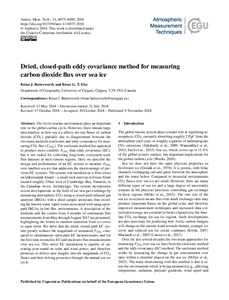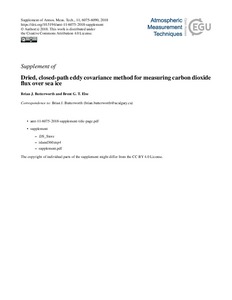| dc.contributor.author | Butterworth, Brian J. | |
| dc.contributor.author | Else, Brent G. T. | |
| dc.date.accessioned | 2019-01-30T21:38:22Z | |
| dc.date.available | 2019-01-30T21:38:22Z | |
| dc.date.issued | 2018 | |
| dc.identifier.citation | Butterworth, B. J. and Else, B. G. T.(2018) Dried, closed-path eddy covariance method for measuring carbon dioxide flux over sea ice. Atmopsheric Measurement Techniques, 11, pp.6075-6090,. DOI:https://doi.org/10.5194/amt-11-6075-2018 | en_US |
| dc.identifier.uri | http://hdl.handle.net/11329/826 | |
| dc.identifier.uri | http://dx.doi.org/10.25607/OBP-381 | |
| dc.description.abstract | The Arctic marine environment plays an important role in the global carbon cycle. However, there remain large uncertainties in how sea ice affects air–sea fluxes of carbon dioxide (CO2), partially due to disagreement between the two main methods (enclosure and eddy covariance) for measuring CO2 flux (FCO2). The enclosure method has appeared to produce more credible FCO2 than eddy covariance (EC), but is not suited for collecting long-term, ecosystem-scale flux datasets in such remote regions. Here we describe the design and performance of an EC system to measure FCO2 over landfast sea ice that addresses the shortcomings of previous EC systems. The system was installed on a 10 m tower on Qikirtaarjuk Island – a small rock outcrop in Dease Strait located roughly 35 km west of Cambridge Bay, Nunavut, in the Canadian Arctic Archipelago. The system incorporates recent developments in the field of air–sea gas exchange by measuring atmospheric CO2 using a closed-path infrared gas analyzer (IRGA) with a dried sample airstream, thus avoiding the known water vapor issues associated with using open-path IRGAs in low-flux environments. A description of the methods and the results from 4 months of continuous flux measurements from May through August 2017 are presented, highlighting the winter to summer transition from ice cover to open water. We show that the dried, closed-path EC system greatly reduces the magnitude of measured FCO2 compared to simultaneous open-path EC measurements, and for the first time reconciles EC and enclosure flux measurements over sea ice. This novel EC installation is capable of operating year-round on solar and wind power, and therefore promises to deliver new insights into the magnitude of CO2 fluxes and their driving processes through the annual sea ice cycle. | en_US |
| dc.language.iso | en | en_US |
| dc.rights | Attribution 3.0 IGO | * |
| dc.rights.uri | http://creativecommons.org/licenses/by/3.0/igo/ | * |
| dc.title | Dried, closed-path eddy covariance method for measuring carbon dioxide flux over sea ice. | en_US |
| dc.type | Journal Contribution | en_US |
| dc.description.refereed | Refereed | en_US |
| dc.format.pagerange | pp.6075-6090 | en_US |
| dc.identifier.doi | https://doi.org/10.5194/amt-11-6075-2018 | |
| dc.subject.parameterDiscipline | Chemical oceanography | en_US |
| dc.bibliographicCitation.title | Atmospheric Measurement Techniques | en_US |
| dc.bibliographicCitation.volume | 11 | en_US |
| dc.description.sdg | 14.3 | en_US |
| dc.description.eov | Inorganic carbon | en_US |
| dc.description.bptype | Best Practice | en_US |
| dc.description.bptype | Standard Operating Procedure | en_US |
| obps.contact.contactname | Brian J. Butterworth | |
| obps.contact.contactemail | (brian.butterworth@ucalgary.ca | |
| obps.contact.contactorcid | https://orcid.org/0000-0002-8457-5308 | |
| obps.resourceurl.publisher | https://www.atmos-meas-tech.net/11/6075/2018/ | en_US |
 Repository of community practices in Ocean Research, Applications and Data/Information Management
Repository of community practices in Ocean Research, Applications and Data/Information Management


